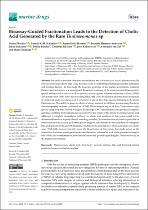| dc.contributor.author | Schneider, Yannik K.-H. | |
| dc.contributor.author | Pheiffer, Fazlin | |
| dc.contributor.author | Holst Hansen, Espen | |
| dc.contributor.author | Hammer Andersen, Jeanette | |
| dc.date.accessioned | 2023-02-08T07:52:12Z | |
| dc.date.available | 2023-02-08T07:52:12Z | |
| dc.date.issued | 2023 | |
| dc.identifier.citation | Pheiffer,F . et al. (2023) .Bioassay-Guided Fractionation Leads to the Detection of Cholic Acid Generated by the Rare Thalassomonas sp. Mar. Drugs. 21, 2. https:// doi.org/10.3390/md21010002 | en_US |
| dc.identifier.uri | https:// doi.org/10.3390/md21010002 | |
| dc.identifier.uri | http://hdl.handle.net/10566/8379 | |
| dc.description.abstract | Bacterial symbionts of marine invertebrates are rich sources of novel, pharmaceutically
relevant natural products that could become leads in combatting multidrug-resistant pathogens
and treating disease. In this study, the bioactive potential of the marine invertebrate symbiont
Thalassomonas actiniarum was investigated. Bioactivity screening of the strain revealed Gram-positive
specific antibacterial activity as well as cytotoxic activity against a human melanoma cell line (A2058).
The dereplication of the active fraction using HPLC-MS led to the isolation and structural elucidation
of cholic acid and 3-oxo cholic acid. T. actiniarum is one of three type species belonging to the genus
Thalassomonas. The ability to generate cholic acid was assessed for all three species using thin-layer
chromatography and was confirmed by LC-MS. The re-sequencing of all three Thalassomonas type
species using long-read Oxford Nanopore Technology (ONT) and Illumina data produced complete
genomes, enabling the bioinformatic assessment of the ability of the strains to produce cholic acid.
Although a complete biosynthetic pathway for cholic acid synthesis in this genus could not be
determined based on sequence-based homology searches, the identification of putative penicillin or
homoserine lactone acylases in all three species suggests a mechanism for the hydrolysis of conjugated
bile acids present in the growth medium, resulting in the generation of cholic acid and 3-oxo cholic
acid. With little known currently about the bioactivities of this genus, this study serves as the
foundation for future investigations into their bioactive potential as well as the potential ecological
role of bile acid transformation, sterol modification and quorum quenching by Thalassomonas sp. in
the marine environment | en_US |
| dc.language.iso | en | en_US |
| dc.publisher | Pubmed | en_US |
| dc.subject | Thalassomonas | en_US |
| dc.subject | Bile acid | en_US |
| dc.subject | Cholic acid | en_US |
| dc.subject | Bioactivity | en_US |
| dc.title | Bioassay-guided fractionation leads to the detection of cholic acid generated by the rare thalassomonas sp. | en_US |
| dc.type | Article | en_US |

